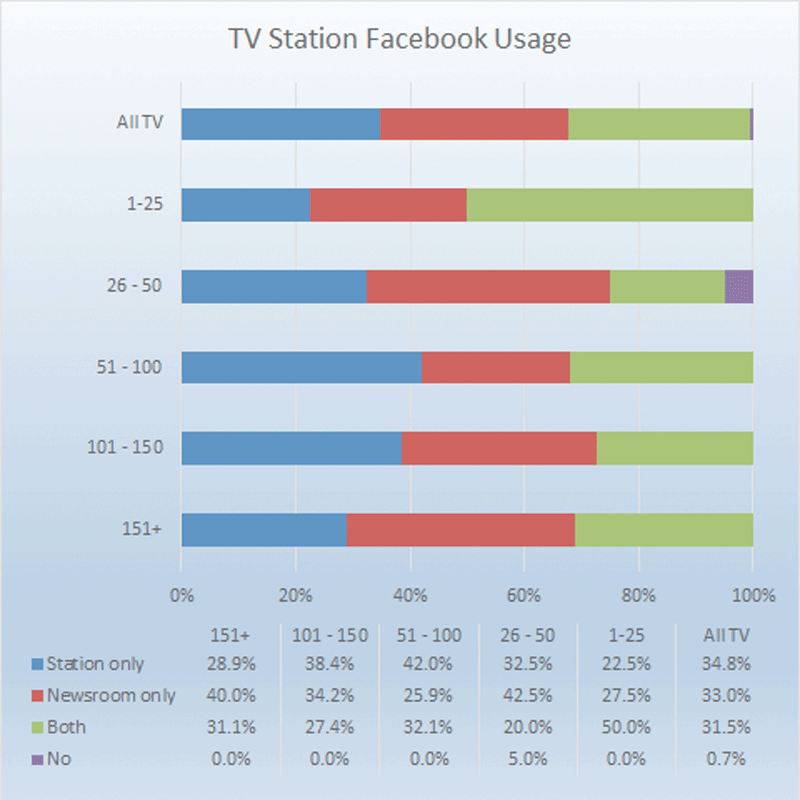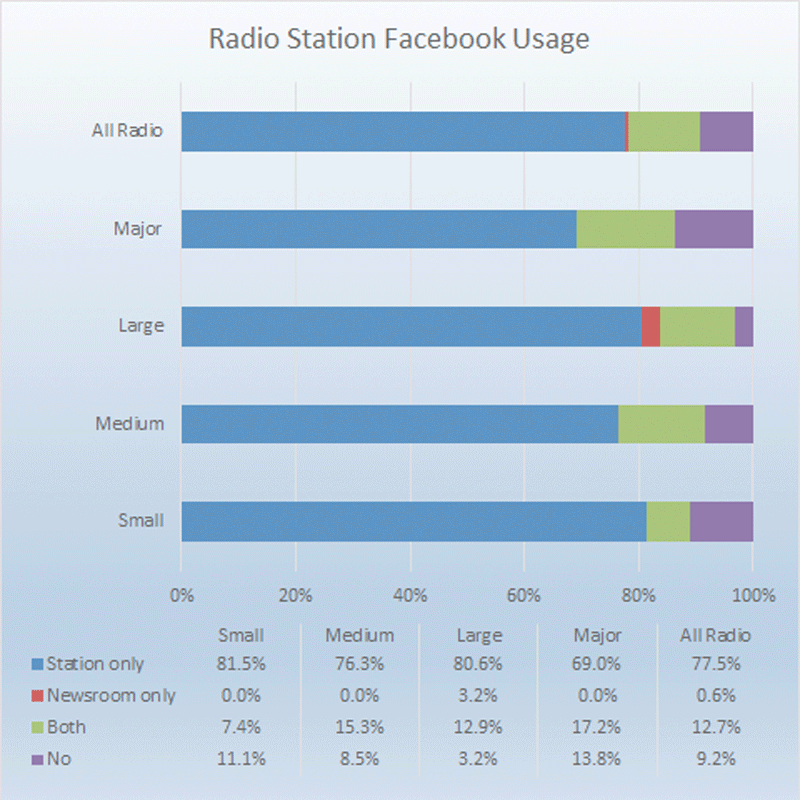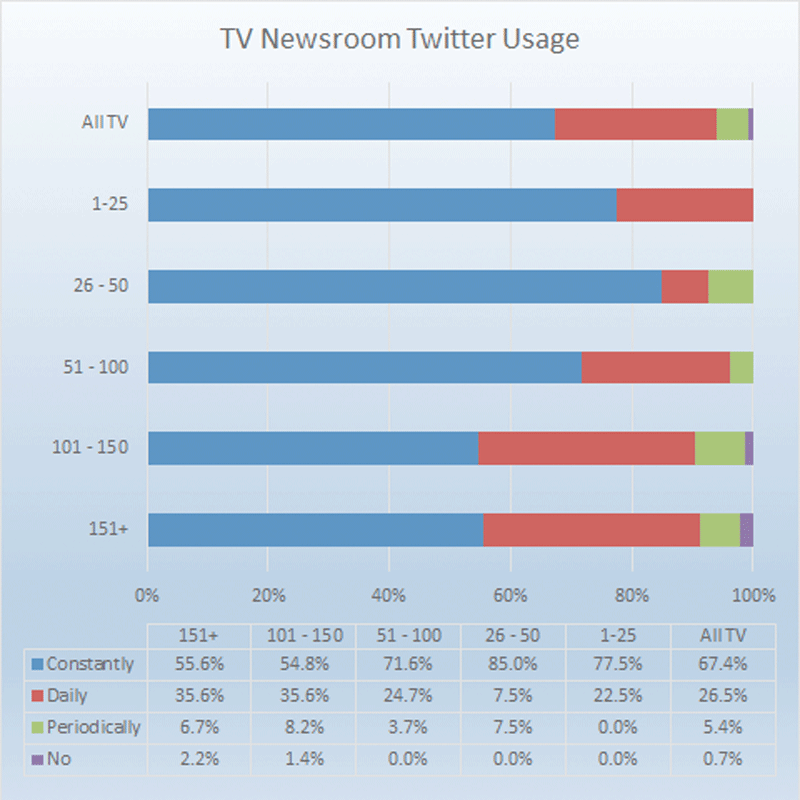Stations grow in social, mobile [INSIGHT]
May 13, 2015
![]() This is the third in a series of reports developed from RTDNA’s annual survey of newsrooms across the United States. Topics in the series include story coverage, what’s new online, social media and mobile strategies, television and radio technology, budgets and profits, stations doing news, news director profiles, and our most popular areas of research; newsroom salaries, women and minorities in newsrooms, and broadcast newsroom staffing. A new report will be issued every two weeks through the month of July.
This is the third in a series of reports developed from RTDNA’s annual survey of newsrooms across the United States. Topics in the series include story coverage, what’s new online, social media and mobile strategies, television and radio technology, budgets and profits, stations doing news, news director profiles, and our most popular areas of research; newsroom salaries, women and minorities in newsrooms, and broadcast newsroom staffing. A new report will be issued every two weeks through the month of July.
Social and mobile highlights:
- Fine tuning social media
- The most innovative new projects
- A range of answers to what’s new in mobile
What’s the most important new thing you started doing with social media in 2014?
About 150 TV news directors gave specific answers to this question. At the top of the list — noted by almost half the news directors — organization, planning and emphasis. News directors talked about putting together a specific plan for dealing with social media; they talked about establishing schedules for each staffer (or key groups of staffers) to post on Facebook or Twitter (or something else); they talked about establishing a social media desk or hiring a new (or converted) social media manager, director, coordinator or producer; some just talked about putting more emphasis on social media, but usually with a specific plan rather than a vague hope; some are still working on establishing a plan.
A quarter of the TV news directors talked about more or better content, especially posted to Facebook but also to Twitter. Some noted an end to auto-posting and establishing more targeted posts while others talked about increasing auto-posting; a few noted contesting.
About 13% used the word “engagement” to describe what they were doing that was new. Some set up specific programs like “behind-the-scenes” looks at the newsroom; some talked about working a lot harder at creating and maintaining “conversations” with the audience. Asking — and answering — questions. At just about the same level, news directors talked about greater emphasis on Twitter. Going “all out” on posting.
At about 6% of replies, we have several areas: more fans and/or fan pages on Facebook; more efforts to link social media (especially Facebook and Twitter) back to the web; and more efforts to link social media and TV newscasts.
A few news directors mentioned other social media software — although way fewer than in past years. Most of those mentions noted Instagram, but there were also votes for Google+ and Linked In.
In TV, 72.4% of news directors said they did something new in social media in 2014 while 27.6% said nothing new. Radio ran the other way: 42.9% said they did something new in social media in 2014, but 57.1% said no, nothing new.
“More” was the radio word of the survey in social media. More actively engaged in social media mostly; getting the staff more involved as well. And there were even more specific mentions of using Twitter than using Facebook, although both were quite high. Also making a decent showing: the increased use of pictures, both still and video.
Other software noted: Instagram, Pinterest and Tumblr.
Last year, quite a few TV news directors gave expansive answers that I excerpted; this year, not so much. But a couple of radio comments are worth reprinting:
“Began to focus on daily posts of interest to the community, including many things that aren’t broadcast worthy.”
“Connecting our programming to Facebook and Twitter daily.”
Facebook
Does the TV station or newsroom have a Facebook page?

Most of these numbers are similar to last year, but I did find a couple TV stations that reported that they did not have either newsroom or station Facebook pages.
Does the radio station or newsroom have a Facebook page?

Radio use of Facebook has been rising steadily, if slowly, until this year. Overall use actually dropped almost a point from a year ago. Most of that drop came from a lot more major market stations in this year’s survey that don’t use Facebook at all. Hard to understand in 2015.
Twitter
Is the TV newsroom actively involved with Twitter?

Overall Twitter use in TV newsrooms didn’t change much, but quite a few newsrooms that a year ago reported “daily” use moved into the “constantly” column this year, up about 12 points. That was especially true for the biggest stations and the biggest markets. “Periodic” use was unchanged.
Is the radio newsroom actively involved with Twitter?

In contrast to Facebook, the radio use of Twitter rose by nearly 9 points from a year ago, with the biggest growth coming in small markets and then large markets. Major and medium stayed about the same.
Mobile
What’s the most important new thing you started doing with mobile in 2014?
Surprisingly, at least to me, there was a little less going on in mobile this year than last. A year ago, two-thirds of TV news directors said they were doing something new with mobile. This year, the number dropped to 59%. Generally, the bigger the newsroom the more likely that the station was doing something new. Network affiliation didn’t matter, but legacy network affiliates, generally, were more than 20 points more likely to be doing something new than other commercial stations. Geography didn’t matter.
About 130 TV news directors answered the question this year in the latest RTDNA/Hofstra University Annual Survey. That’s fewer than last year’s 200, but the challenge is always coalescing those answers into something that makes sense. And the answers to the question this year were far different from last year. A year ago, the runaway winner was having a plan for what the station was going to do. This year was far more about execution. Well over half the answers talked about the development, implementation or improvement of apps.
In TV, weather apps and streaming apps tied for top honors — both were double a non-specific mention of “apps” — news alerts and new or improved news apps. Streaming included live newscasts, live events, recorded newscasts and video. There were scattered mentions of apps for high school sports, school closings, traffic and specific program apps.
Far behind apps, the next group included non-specific or just more emphasis on mobile, more and better content, better design and/or navigation, and better management, oversight and planned approach to social media.
Interestingly, Facebook barely got mentioned. But maybe that’s because it goes without saying. Or maybe not.
While nearly 60% of TV news directors listed something new that they did in mobile in 2014, radio was the reverse. More than 60% (63.2%) of radio news directors said they did nothing new in mobile in the last year.
For the 36.8% who said they did something new, more than half pointed to the development of one or more mobile apps. And those apps covered just about everything: local sporting events, local sports scores, live streaming, streaming stuff that wasn’t live, apps for listening, apps for iPhone, Android and Blackberry. Who knew anyone still used a Blackberry?
To give you an idea of how dominant the app answer was: While 55% of radio news directors and general managers noted apps, the next most popular answer was streaming at 11%. Of course, streaming is really app development anyway. Several noted redesigning the website to make it more mobile friendly. That was a bigger push a year ago. Then it was just scattered answers relating to things like more content, adding video, more use of news alerts, texts and use of Twitter. Among the software most often mentioned: NPR One, TuneIn Radio and Instagram.
Non-commercial stations were twice as likely to say that they were doing something new in mobile compared to commercial stations. The biggest newsrooms and stations in major markets most often noted something new.
Apps
The percentage of TV stations with apps remained at exactly 87.8% this year. Generally, the bigger the staff, the more likely that the station had one or more apps. The average station had 1.8 apps and the median was 2. That’s almost identical to the last two years. The top station had 15 apps; last year, the winner had 10. Only 2.1% of stations charged for apps. That’s down from about 3% last year and 6% the year before.
In radio, about half of stations, 49.7%, had 1 or more apps, and the average station had 0.9 apps. Both numbers are up markedly from last year, about 15 points for having an app and nearly double the average number. Still, the typical radio station still has zero apps. The maximum in radio was 10, and that was at a small market station in the West. Not a single radio station reported charging for apps this year.
Author Information: Bob Papper is Emeritus Distinguished Professor of Journalism at Hofstra University and has worked extensively in radio and TV news. This research was supported by the Lawrence Herbert School of Communication at Hofstra University and the Radio Television Digital News Association.




























